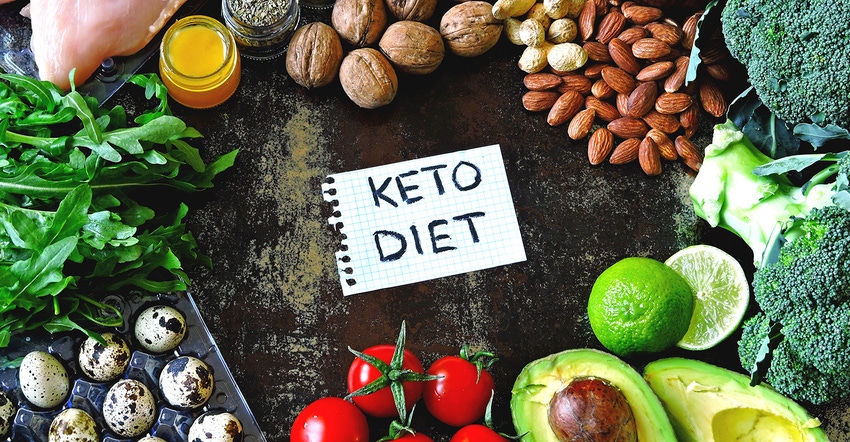Understanding the basic science behind the keto diet can help brands develop appealing products for the low-carb crowd.

The keto craze shares DNA with the Atkins diet—the low-carb diet phenomenon that gained traction right about the time nutritional authorities learned/revealed it was not true that simply eating fat causes one to become fat. Turns out it’s carbohydrates that both provide quick energy but then become stored in the body as fat. So the Atkins diet counseled overweight consumers to shun the carbs instead and that would lead to rapid weight loss.
The same goes for keto. However, where Atkins was low carb and high protein, keto is extremely low carb, moderate protein and high fat. The keto diet has ratios of about 70% to 75% fat, 20% to 25% protein, and 5% carbohydrates. When the body has limited glucose available—it makes glucose first from carbs and then from protein, if necessary—it goes into ketosis and burns more fat for energy, which can lead to weight loss. During ketosis, the body also makes more ketones—primarily acetone, acetoacetate and beta-hydroxybutyrate (BHB); for instance, the brain prefers glucose and cannot use fat well as fuel, but it can run on ketones.
Weight Loss
A recent clinical trial on 95 subjects with an obesity body mass index (BMI) of 37 found that after eight weeks of a keto diet, the mean weight loss was 17% for males and 15% for females.1 Even when the study subjects went back on their regular diets, the weight loss remained off until the study ended at 13 weeks.
Other researchers conducted a meta-analysis of keto diets, comparing a keto diet with a conventional low-fat diet with 12 months or more of follow-up.2 The keto diet led to greater weight loss compared to the low-fat diets. Also notable was that the keto diet led to improved outcomes in triglycerides, diastolic blood pressure, high-density lipoprotein (HDL or “good”) cholesterol and low-density lipoprotein (LDL) cholesterol levels.
Blood Sugar
Because of these metabolic syndrome symptom abatements, the keto diet has also been researched to aid obese patients with type 2 diabetes
CDC reported that more than 100 million American adults are now living with diabetes or prediabetes (which, if not treated, often leads to type 2 diabetes within 5 years). Diabetes, CDC said, can often be managed through physical activity, diet, and the appropriate use of insulin and other medications to control blood sugar levels.
“More than a third of U.S. adults have prediabetes, and the majority don’t know it,” said CDC Director Brenda Fitzgerald, M.D. “Now, more than ever, we must step up our efforts to reduce the burden of this serious disease.”
Diabesity
Can the keto diet come to the rescue and put a dent in the post-modern disease states of diabetes and obesity? The two conditions are now so prevalent that the two have been joined at the hip to form a new condition: diabesity.
Research is pointing to the keto diet not only helping with weight loss but also improving insulin sensitivity in people with type 2 diabetes.
In one small, short study among 10 patients for two weeks, patients experienced weight loss, improved 24-hour blood glucose profiles, improved insulin sensitivity and hemoglobin A1c (average blood sugar levels over the past three months), as well as decreased triglyceride and cholesterol levels.3
This landmark study was credited by other researchers as being “nicely done” and “shows the importance of scholarly evaluation of popular diets, which ideally should take place before they appear in a consumer-oriented book.”4
Product Formulations
The typical fats encouraged in a keto diet include medium-chain triglycerides (MCT), as well as avocados, olive oil, nuts and seeds with moderate amounts of nut butters, butter and cheese.
Manufacturers are responding to the keto craze by rolling out products that meet consumers on their keto journey, as evidenced by keto-certified products on exhibit at Natural Products Expo West. The number went from 194 such products on the show floor in 2017, to 406 products at Expo West 2019.
“This data is not claim-based, but encompasses products that fall within keto trend parameters such that they are at the least, low-sugar/low-carb and potentially high in fat,” said Amanda Hartt, market research manager for NEXT Data & Insights at New Hope Network, which is owned by Informa Markets and produces the Natural Products Expos. “In other words, coffee drinks are captured because coffee can be considered inherently ketogenic since it’s low carb, so many coffee items can fall into this attribute trend that don’t necessarily have a keto claim,” she explained.
NEXT Data & Insights reported that “categories actively reformulating or growing to ride the momentum of keto-minded consumers include snacks, energy and granola bars, salad dressings, cheese, and nut and seed butters.”
Other product categories moving into the keto set, according to SPINS data, include ice cream, pasta and rice alternative, baked goods and functional beverages.
Several organizations offer a certification program for keto products. The “Keto Certified” seal from the Paleo Foundation launched in 2016, and now boasts 3,200 different products.
To be keto-certified under this program, a product can have 10 grams net carbs per serving, while 6 grams per serving are allowed for snacks and 2 grams per 0.5 ounces for condiments. The certification also looks at net carbs (i.e., total carbs minus fiber and sugar alcohols), which is breathing additional life into the fiber conversation.
Five keto food ingredients
Fiber is an important one because it counts against carbohydrates in certified keto CPG products. Ingredients such as chicory root and acacia add a bonus because they are also prebiotic fibers.
Bone broth can be both gluten and sugar-free, with lots of protein.
Coconut and palm-derived MCT oil provides high-density, plant-based energy.
Sugar alcohols like allulose and erythritol, as well as the alternative sweetener monk fruit, can decrease or entirely cut out sugar from products.
Hummus is a lifesaver for keto adherents. It’s made from chickpeas, olive oil, tahini, lemon juice, garlic, salt and pepper.
Five keto supplement ingredients
MCTs have shorter molecular chain lengths than the fats found in most other foods, so are broken down and absorbed into the body faster, thus making them a quick energy source.
Magnesium is the master mineral. Keto followers may be particularly prone to a deficiency because foods naturally high in magnesium, like beans and fruits, are also high in carbs and thus not eaten regularly.
Omega-3s are helpful for those on a high-fat diet to keep in check the omega-3 to omega-6 ratio. In addition, science shows keto subjects also taking omega-3 supplements had even greater decreases in triglycerides, insulin and inflammatory markers compared to those who did not.5
Enzymes: In light of increased fat intake, lipase enzymes—as well as proteolytic enzymes to help with protein digestion—may aid people contending with the very different macronutrient matrix surrounding a keto diet.
Exogenous ketones: The more the merrier, and this is a way for keto diet followers to reach ketosis more quickly. BHB is the main ketone available as a dietary supplement.
References
1 Lyngstad A et al. “Investigating the Effect of Sex and Ketosis on Weight-Loss-Induced Changes in Appetite.” Am J Clin Nutr. 2019;109(6):1511-1518.
2 Bueno NB et al. “Very-Low-Carbohydrate Ketogenic Diet v. Low-Fat Diet for Long-Term Weight Loss: A Meta-Analysis of Randomised Controlled Trials.” Br J Nutr. 2013;110(7):1178-1187.
3 Boden G et al. “Effect of a Low-Carbohydrate Diet on Appetite, Blood Glucose Levels, and Insulin Resistance in Obese Patients with Type 2 Diabetes.” Ann Intern Med. 2005;142(6):403-411.
4 Bray GA. “Is There Something Special about Low-Carbohydrate Diets?” Ann Intern Med. 2005;142(6):469-470.
5 Paoli A et al. “Effects of n-3 Polyunsaturated Fatty Acids Supplementation on Some Cardiovascular Risk Factors with a Ketogenic Mediterranean Diet.” Mar Drugs. 2015;13(2):996-1009.
About the Author(s)
You May Also Like






.png?width=800&auto=webp&quality=80&disable=upscale)